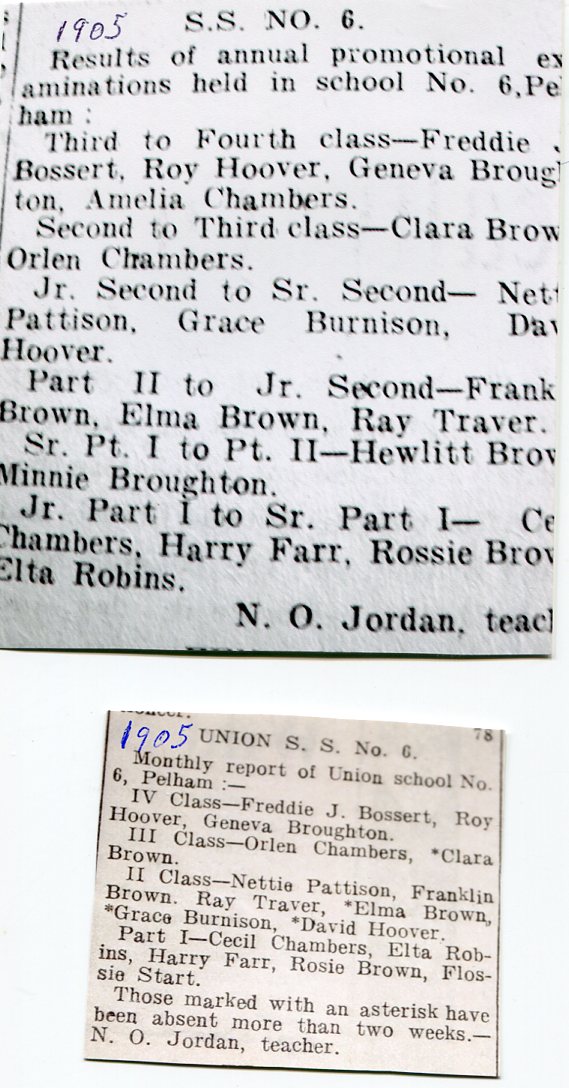Results for ‘Schools’
[Pelham Historical Calendar 1981]
Prior to 1910, U.S.S. #3 was a 2 roomed school (brick), more attractive on the outside than the inside.
Despite the fact that its interior was dark (due to dark coloured paint, no electricity and windows placed high up) the pupils were taught the 3 R’s by capable teachers and ones who commanded obedience. Mr. Jas. Wright, Mr. R. Grant, and Mr. Duncan Baxter were some of the principals while a local girl. Miss Grace Barron was a junior teacher. Miss Eckart of Ridgeville and Miss McLeod of Stamford were other junior grade teachers.
If there was any lighting, it was by means of coal oil lamps. Heating was by coal stoves and there was no indoor plumbing. For drinking purposes, a bucket and dipper were sufficient. Outdoor apparel was hung in the entry.
 |
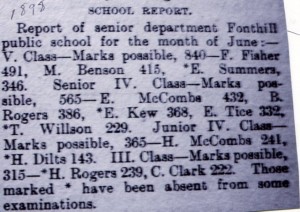 |
The furniture consisted of double, varnished maple desks, bolted to the floor and a teacher’s desk. Each child had a slate, a slate pencil, a pen with a steel nib and a scribbler. The most important item in the teacher’s desk was the strap. A picture of Queen Victoria hung on the wall.
You began in the First Book, and proceeded to Jr. And Sr. Second and so on until you reached Sr. Fourth. To go to High School, you tried Entrance Exams.
School was from 9:00a.m. until 4:00 p.m. each day with a recess of 15 minutes morning and afternoon. Lunch break was one hour. Classes were summoned by means of a hand bell.
Summer holidays were from June 30- August 15. There was a week’s holiday at Christmas and 4 days from Good Friday until Easter Monday. Victoria Day (May 24) was celebrated on the exact date.
Schoolground equipment was nil and if you played ball, the bat was a piece of wood.
The board of trustees were willing unpaid people, from the Townships of Pelham and Thorld. The inspector was Mr. A,M, Ball who visited the school twice a year. The Minister of Education for the Province of Ontario was also from nearby- the Hon. Richard Harcourt of Welland.
In 1910, following a great deal of arguing over a price tag of $10,000.00 a new , 4 room, red brick school was erected. Many tax payers were of the opinion that a school of that size would never be filled.
By 1921, however, the enrolment was such that one of the basement rooms (the one to the south) was converted into a classroom for the beginners, and it remained that way until one of the late inspectors (in the late 1930’s) termed it “The Black Hole of Calcutta”. An annex at the northwest corner resulted from the remark.
One cold Sunday morning, January, 1923, an event occurred which did such good despite the damage. This was an electrical fire in the two northerly rooms. A volunteer bucket brigade fought it for some hours. This resulted in (1) the installation of slate boards and (2) drawing attention to the need for a fire department and a waterworks system.
In 1949, two rooms were added to the south at a cost of $50,000.00. Then, in 1953, four more classrooms plus other facilities were constructed at a cost of $153, 000.00 The annex was removed and over the years, two portables have replaced it.

Arthur K. Wigg has the distinction of being principal from 1938-1972—a total of 34 years. Two local teachers, as well served the Fonthill Public School Board for long terms- Miss Marjorie Stirtzinger for 34 years and Mrs. Marjorie (McInnis) Jenter for 36 years.
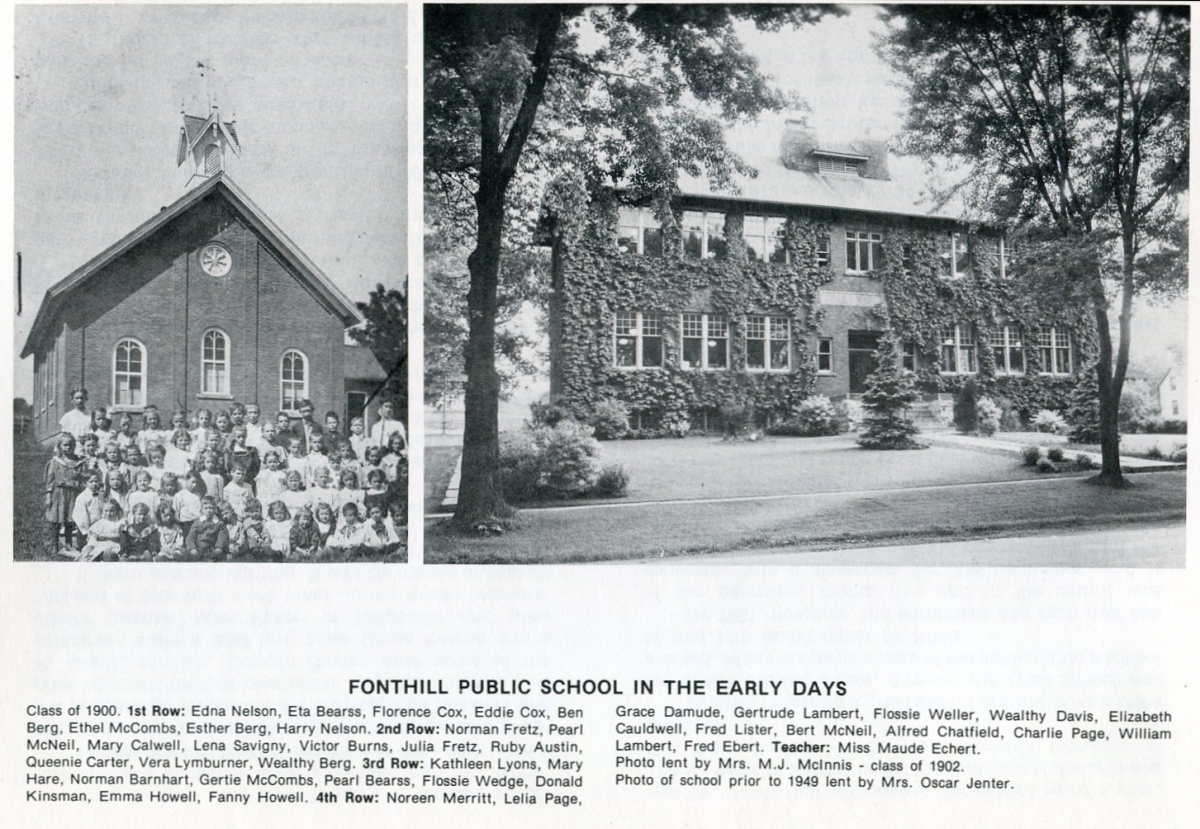
Quality education for each and every child as an individual has for many years been the goal of staff and administrators in the Fonthill Elementary School system
Marjorie L. Jenter
[Author Unknown]
This one-room schoolhouse was built in 1852, and served pupils from four townships- Pelham, Gainsborough, Clinton and Louth- until 1965, when it closed. The land had been bought for five pounds from John Cosby and the present school built, replacing an earlier from structure located on the opposite corner. The bricks were made from clay found on the Cosby farm.
A bell was purchased in the early 1900’s, a large slate blackboard installed and an organ and piano were bought for musical instruction. In 1907, additional land was purchased and the school grounds were extended.In 1945, Pelham Union School won first prize in the school beautification contest in Welland County and fifth provincially. The school continued to win prizes, with pupils planting shrubs, a perennial garden, a large circular bed of annuals, and window boxes on the west wa;; filled with bright flowers. Fence posts, a flagpole and pump were kept painted, and a bucket well was erected with funds from the prize money.
The Pelham Recreational Board assumed control of the school when it closed in 1965 and the Women’s Institute of Pelham Union began to use it as a meeting place and community hall.

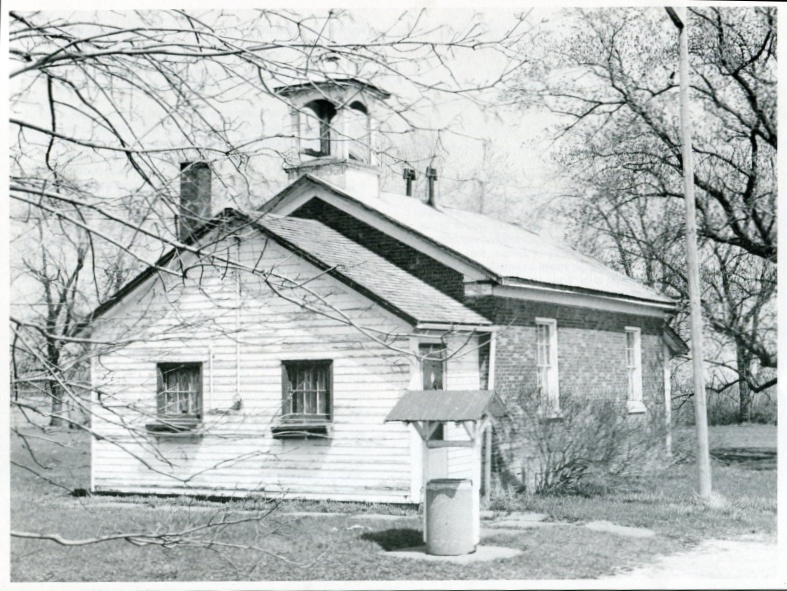
PELHAM UNION SCHOOL
[Pelham Historical Calendar 1978]
The one-room schoolhouse- with Ontario Readers, heating stoves and inkwells- is a memory now.This little,red brick schoolhouse is one of the oldest in the area. It served four townships- Pelham, Gainsboro, Clinton, and Louth- until as recently as 1965.
The 100th anniversary of the school was celebrated in 1952. A century earlier, “Twenty-one Square rods of land were bought for five pounds from Mr. John Cosby”, and the present brick school was built, replacing an earlier frame structure on the opposite corner. A brick-making machine was used to shape clay from Mr. Cosby’s farm into the bricks for the school.
In the early 1900’s a bell was purchased, a large slate blackboard installed and an organ and piano were bought for the musical instruction offered to the children. The sturdy double desks were still in use when the school closed, and many desks were bought by former pupils. In 1907 more land was purchased and the school grounds were extended.
School Beautification Contests were an important part of school life. In 1945 Pelham Union School won first prize in the Welland County contest and fifth provincially. Each year after that the school entered and received prizes. Pupils helped plant shrubs, a perennial garden, a large circular bed of annuals. Window boxes brightened the west wall. Fence posts, flagpole and pump were kept freshly painted. A bucket well was erected, with funds from the School Beautification prize money, when Miss Lillian Neal retired in 1951 after teaching in the school for thirty-nine years.
When thr Pelham Township school area was formed the children of this school were taken by bus to other Pelham schools. Pelham Union School closed in June 1965. The building is now managed by the Pelham Recreation Board. It is used and looked after by the Women’s Institute of Pelham Union, Community Buildres Branch. The school, in outer appearance, is much the same as when the three R’s were drilled, and the mornings began with singing “God Save The Queen.”
U.S.S. no. 7 PELHAM UNION (PUTT’S INN)
[Author Unknown]
This school is one of the oldest in the area and is situated in the northwest corner of Pelham Township. The pupils of U.S.S. #7 lived in Pelham, Gainsborough, Clinton and Louth Townships. As the records have been inadvertently destroyed, information has been meagre and this has been compiled from the memories of pupils.
Little is known of the first school which was a few yards south of the present building, on rather low ground.
Around 1850, the present brick building was constructed on the corner of “Schoolhouse Lane” and the “Townline.” This small lot was a part of the property owned by Murray Cosby. It had been granted to the Cosby family as United Empire Loyalists. Later, the farm was owned by his daughters, Mrs John Haist who taught at the school in the late 1880’s with about 8 dozen pupils. The school yard was small with a board fence just west of the well and a few feet north of the school. The woodshed was a small separate building.
In the early days, the desks were long and placed lengthwise in the room under the windows. These long desks and benches were often a disturbing factor when one pupil wished to raise the desk lid while the other wrote. From about 1875 until the school was closed, double desks without lids were used in the traditional arrangement in the room. Samples of these desks may still be seen in the neighbourhood.
The older boys took turns building the wood fire to heat the building. Periodically, a fire was lit outdoors to heat water for the girls to scrub the floor. The small entry at the west was a place for the water pail and dipper and for coats.
Probably in the early 1900’s, the school yard was doubled in width and extended west to the town line. The rather large woodshed was attached to the east end of the building.
During Miss Neal’s forty years as teacher, many things changed. Even though there was caretaker services for lighting fires and sweeping the floor and dusting, one day in May was a cleaning day. On Arbor Day, pupils brought cleaning equipment, rakes and hoes, etc. The yard was raked windows, woodwork and floors were cleaned and flowers planted. Work proceeded quite rapidly even though the number of pupils were often very small because the day ended with a walk to the woods for wildflowers. This was generally to the corner of the Town Line and Tintern Road on the farm of Mr. Peter Bradt.
Christmas concerts were big events when stage entrances were made from icy woodshed or from behind the piano. Lighting was by coal oil lamps and later, from borrowed Mantle Lamps or gasoline lanterns. In the early 1930’s, the school was wired for electricity.
The original entry was doubled in size in the 1940’s and converted into washrooms. The old box stove was replaced by an oil space heater about 1955.
In 1965, the Township School Board decided to close the school and transport all pupils south to larger schools. The Community Builders Branch of the Womens’ Institute considered buying the property.. On Hallowe’en however, in that same year, fire destroyed the woodshed and much of the interior of the main building. The Community Builders have done much renovation and are using the building for their activities.
Teachers at U.S.S. #7 (Putt’s Inn)
Flavell Davis 1867-?
Isaac Moyer
Miss Effie Miller 1885-1888 ?
Miss Maggie Cosby (Mrs. John Haist)
John Comfort
Adison Moore
Geo. Henry (6 Mos.)
Adison Moore
Flavell Davis 1896- ?
Miss Lily Lampman
Miss Anna Sheldrick
Miss Mabel Huff (Mrs C. Van Every, Beamsville 1905-1907
Miss Sara McDougall (Mrs. Lorne Gordon, Harrison 1907-1909
Miss Irene Wright
Miss Smart
Miss Lillie Neal 1912-1952
Mrs. Gerald Martin 1952-1955
Mrs. Fretz 1955-1956
Miss Spencer 1956-1957
Mr. James Perry 1957-1962
Miss Wiebe
Mr. Kenneth Hill 1963-1965
Inspectors
Mr. Ball 1880’s
Mr. W.W. Ireland 1905-1913 ?
Mr. Carefoot
Mr. Marshall
Mr. Runnalls
Mr. Peat
For many years, music was taught by St Catharines teachers on a regular basis. The teachers were—Mr. Arthur Hannahson, Mrs. Eva Griffin, Mr. Geo Hannahson.
[Pelham Historical Calendar 1980]
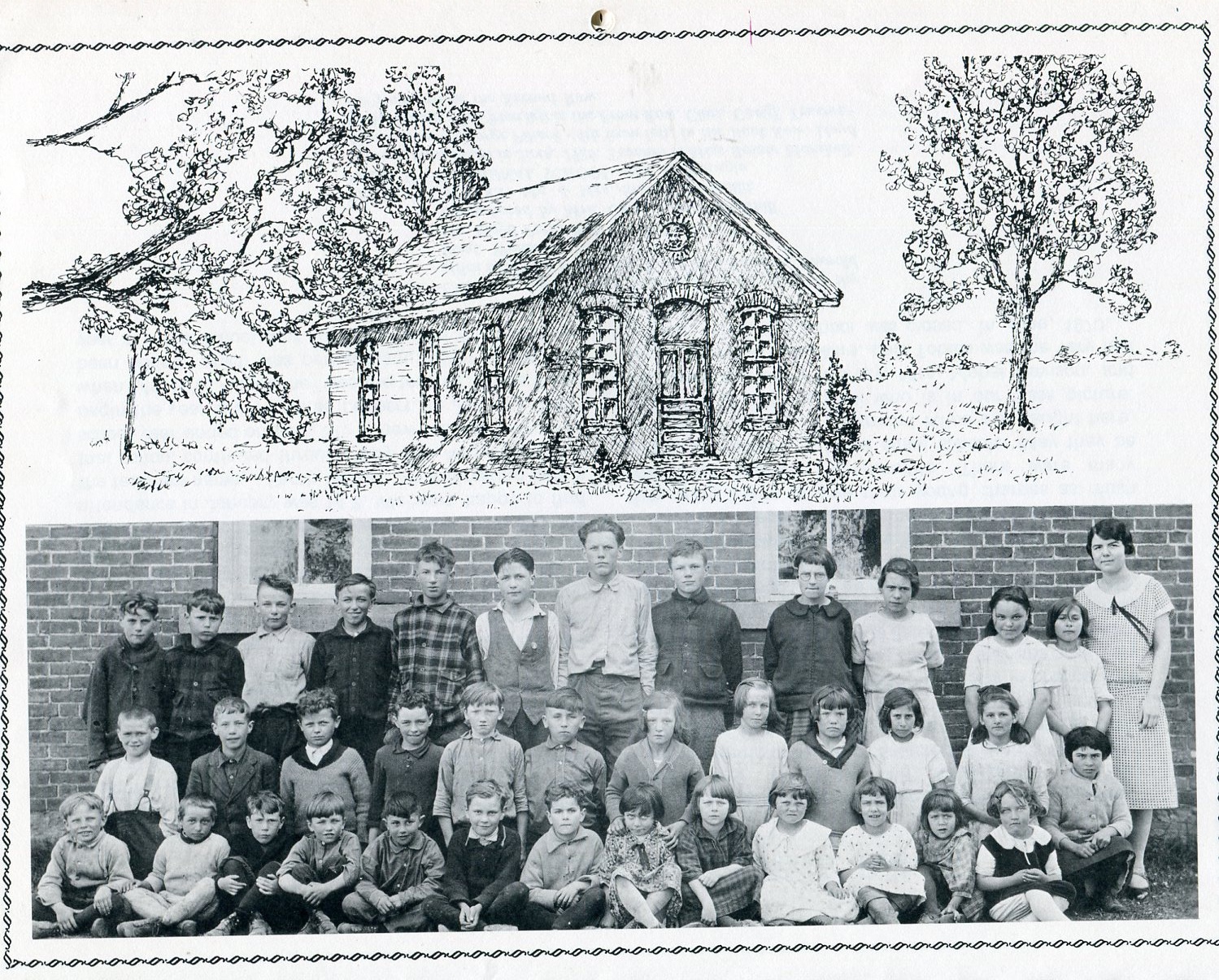
This school was built in 1872, but the original building was on the other side of the tracks. The rural setting is still intact and beautiful. An addition was made in 1961, which enabled it to house two classes very comfortably. The school has been changed into a home now, the owners being Mr. and Mrs. Stanley Miejadlik. Our sketch shows the earliest building.
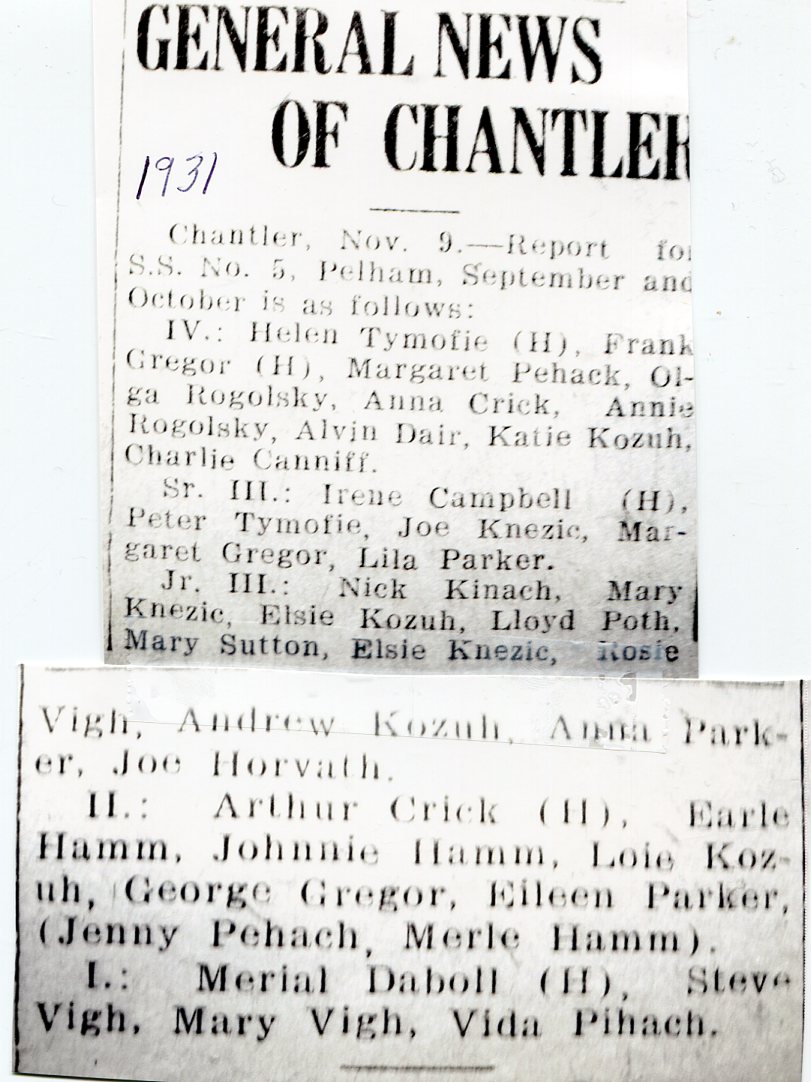 |
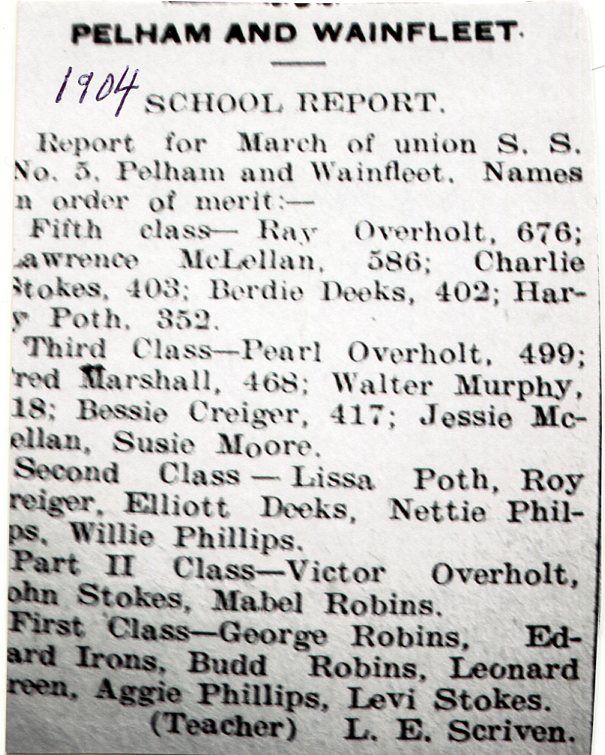 |
The first written information that we found us in the school year January to December, 1890. The pupils were registered in four “Classes”, not grades, totalling twenty-four children. The attendance was not all that it should be, perhaps because of bad roads in wintertime, and chores at home in the warm weather. The average attendance in January was 14.3. We were happy to find teachers name Sarah Gaiser. An interesting fact is that school continued through July and August and the school year ended on Dec. 31. A new teacher arrived to begin the year 1891, Annie Leppert. In January, 1899, when Mr. E.V. Augustine was the teacher, class 5 had been added, which was perhaps equivalent to the first year of High School now. In 1922, when the inspector, Mr. J.W. Marshall signed the register, he remarked, “Neat and Complete and Well-kept.” It was heart-warming to see the “Selected Scripture Readings” in the front of the register, and to all appearances it was well-used.
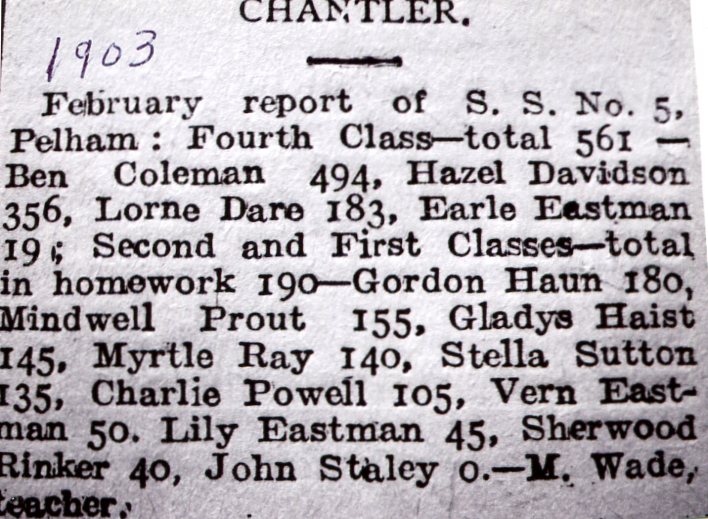
On Sept. 1, 1921, Mildred Haist was in charge with six “levels” of pupils. We conclude that she was very satisfactory, as we see she is listed as teacher until 1925, with thirty pupils and seven grades to manage. She may have stayed longer, but we have no written proof. In 1929 when the enrolment rose to forty-one, two teachers were considered necessary—Viola R. Culp and Laura P. Fee. As they were separated into nine classes, it is obvious that they were trying to give their young charges as much individual attention as possible. There were many excellent teachers in these small schools. My they be long remembered. Mr. Edmund Kline also taught here, and Miss Bessie Marshall who is in our class picture. Following Mr. Jerry Murray, Mrs Mabel Davison and Mrs. Catherine Rice, Mrs. Lois Tobias was the very last teacher, when the school was closed, in June, 1970.
[Pelham Historical Calendar 1981]
The Original Hansler School was built by the Becketts in 1821, on property donated by Mr. Andrew Hansler. It had a good central location between “Beckett’s Mills and Temperanceville.” (Effingham and Fonthill) This school building was in use from 1821 until 1860. A second school was built in 1861 and opened in 1862, across the road from the first one, on property donated from the De La Mater farm, specifically for that purpose. We have no idea of the appearance of the first school, but we do know about the second one. It was a one-roomed brick building with a belfry and bell. An attractive porch ran right across the front, with a broad set of steps leading up to it. Of course, the boys and girls had separate entrances from the porch into the school itself.
The second school had a stove inside the classroom, and an outside woodshed where the fuel was stored. From one source, we get the impression that in the early days, the parents of the pupils supplied the wood. This school was apparently used for ninety-six years, because it was on June 28, 1958, that a note was made regarding the intention that the “school be boarded up.” However, it was torn down,. The opening of the third school took place in that September.
There were two classrooms in the new building, also two washrooms, a boiler room, storage room, and office.
Mrs. Marion Guinn continued as the principal. The trustees were Wilford Cook, who also served as Secretary-Treasurer, George Hicks, and William A. Rice. They did not know how few the active years would be, for this fine young building. In 1970, the school was closed and the windows boarded. No longer would children play in the schooolyard and enjoy the marvelous bank of trees to the west, which could be a veritable blaze of glory in the autumn!
Well before 1842, travelling Methodist ministers held their services in the first school, until the Methodist Church was erected in Fonthill. Among those courageous preachers was the Rev, John Ryerson, brother of the educator, Egerton Ryerson.
It is of interest, financially speaking, to find that the coal bill for the year 1919 amounted to $72.10, while the teacher, Mr. G.E. Beckett, received $70.00 a month. In 1923, a chair was purchased from J.T Romp, for exactly $3.00. Perhaps it was a special one, for the visiting Inspector, or even for the teacher’s desk. The teacher-principal at the time was Miss Mary Bowman who had been engaged in 1920.
There is a happy ending to our story, because Mr. and Mrs Wayne Johnson purchased the property in August, 1979, and enjoy living there with their two children, Tamera and Trevor. Mrs. Johnson is operating a school for pre-schoolers there, under the delightful name of “The Children’s Village.”
Lot 6 Concession 6
[Pelham Historical Calendar 1991]
There was a Hansler School in active existence from 1821 until 1970, when the third school building was closed. The first school was built in 1821 on Hansler property and served its purpose until 1860, the second one, built on Martin De La Matter’s land in 1861 was of brick construction with a bell and belfry. It was unique in that it had a wide porch across the front, providing a fine place in which the children could play on rainy days. The pupils sitting beside it in the picture could not foresee its destruction in 1958, the building of a new school on the same property that same year and its closing in 1970. After one hundred and forty-nine years, there was no longer a Hansler School.
It is very important and also difficult to gather memories from a seventy-year old picture, but one thing is very clearly remembered—the love and respect in which the pupils held their teacher, Miss Mary Bowman. They agree that she was strict but always fair and genuinely interested in them. Good discipline prevailed because the clear rules were meant to be followed. Phoebe Cook (later Mrs. David Benson) remarked, “I always loved school and especially my teacher. He was one of the best. If there had been a Teacher of the Year Award at that time, she would have won it.”
However, children being children, some of them were tempted to stray across the road to an empty lot to play football at noon hour and had to pay the penalty—a strapping which in truth seemed to hurt Miss Bowman more than it did them. Two of the boys better left unidentified, enjoyed fighting each other in the schoolyard whenever they thought it safe.
The older children often helped to clean the school after hours, washed blackboards and brought in fuel for the stove, all as willing volunteers. There were special events , of course, to brighten the school year. The whole classroom attended the Fenwick Fair, and George Hicks remembers them performing a drill as part of the entertainment. Arbour Day in the spring meant a full afternoon in Sulphur Springs, appreciating the scenery with its bubbling spring and greening landscape. The very best event of all was the Christmas Concert in which all the children took part. Year after year, Reginald Rowcliffe played a very satisfactory Santa Claus for them. When a duet was required, Ruth Hicks (later Mrs. Edmund Kline) and Bill Rice were expected to sing. Ruth has mentioned how very special the teacher made every experience for them. With her enthusiasm, Miss Bowman left a legacy of precious memories as well as lessons learned.
Regarding the picture, it is interesting that Ruth Cook and George Hicks are side by side in the front row. George says that they were often placed together in the same double seat. Years later they became husband and wife.
Some of the children in this photograph became members of the Literary Society when they were older. It held its meetings at Hansler School and was a thriving concern. There were sing-songs, often by Hansler Swayze, and one of the favorites was The Grandfather Clock”. One of the memorable plays was founded on the Biblical story of Lazarus and Abraham. Taylor Beckett, who took the part of Lazarus, played it most dramatically. There were special nights when children were included and entered contests. Dorothy Cook (later Mrs. Ken Dunton) remembers receiving third prize for singing a solo, with Mr. Harry Daboll handing her the award. She also recalls one night when Mrs. John Andrew Daboll engineered a taffy pull on the stage, much to the delight of the audience.
Bill Rice mentions that when he was about eight years old, Harry Daboll brought a moving picture machine to the meeting and projected the film “Lorna Doone”. It was the first moving picture most of them, including Bill had seen, and it was very exciting Bill also recalls that the whole Daboll family were exceedingly kind to the children of the Hansler School.
Mrs. Marion Guinn, the last principal of the school, has a few memories to share. As a bit of history, two of her grandparents and one great-grandparent attended this school in their own time. Mrs. Guinn remembers that “the trustees were helpful, the students diligent and respectful and the parents very supportive,”– a satisfying conclusion to our “Memories of Hansler School.”
Catherine B. Rice
[Author Unknown]
On the Hansler property, in 1821, was built the first school in this area of Pelham Township—a school which was to last until 1860.

The second school, a one-roomed brick building was in use from 1860-1958. Like many other schools at the time, the structure had a belfry and a bell. There was a porch on the front, separate entance for the boys and the girls, two washrooms and was heated by means of a stove which was situated right in the classroom. Fuel for this stove was stored in an outside woodshed. In addition to the desks, there was a piano in the classroom.

The third building constructed in 1958 was of white brick and had two classrooms, two washrooms, storage room, boiler room and an office.. Off each classroom was a cloakroom for the class.
The school has been closed and its windows boarded (1970). The schools were situated on the corner of Metler and Effingham Roads.
At first, the teachers were paid by those parents whose children were sent to school. Interest was shown as to whether to continue supporting the early schools in this manner or for the schools to be free of charge to the parents and rates levied on everyone’s property.
In those early days, the wood consumed by the heating system was supplied by the parents.
(Note- in 1821, the Becketts built the first school on the Hansler property,. Mr. De La Mater donated land for the school in 1860. This land was across the road from the original school. The school was always known as Hansler’s School.
2502 Effingham Road, Lot 6, Concession 2
[Peham Historical Calendar 1985]
Nestled among some tall trees, on what was once called the Pelham Stone Road, sits a fine brick structure. A remnant of the education of the past, it is now a private home. It was used first as a township school, then for part of a township school area, and was finally closed in June 1965, with the advent of the Niagara South Board of Education, Mrs. Elaine Cuffe was the last teacher principal. Mr. and Mrs. Ralph Roland (Patricia) purchased this property in 1966, and have put in many improvements, but they have kept the exterior facade virtually intact
A record book, the property of Mr. and Mrs. Harold Roland, yields much information about the first school. On the first page, D.D’Everardo signs his name, adding “T. Supt., C.S.” This stands for “Township Superintendent, Common School.”
The land for the school was donated by Nicholas Oille, and the log schoolhouse was erected in 1832, twenty-four feet square. As the old photo shows, it was to the west of the Oille-Sanderson house, now the home of Mr.and Mrs. John Gilmore. The second school, made of brick, was built to the east of the log school, but it burned down, and was cleared away. A third school, also of brick, was built in 1906, and burned down in 1913 or 1914. The foundation of the fourth school was built around the foundation of the third one. While it was being constructed in 1916 and 1917, a house on the Sanderson property was used as a school. When the house was no longer needed, it was moved to Sixteen Road. At one time, there was a double cistern at the back of the school, which was called a “water font.” The water was purified as it passed from one cistern to the other.
Judging from the description of their schools written by pupils in a scrapbook, we glean the idea that they were indeed spartan by modern standards. The equipment consisted partly of a dunce cap and a birch rod. Only the fourth and final school was decorated in warmer tones. Electricity was installed around 1939. The school yard was well landscaped, and awards in the Welland County Beautification Contest were won four times between 1926 and 1930, as depicted on a wooden shield left in the school building.
The earliest mention of trustees was made on January 14, 1845, when George Oille (Chairman), James Disher (Secretary), and Joseph Disher, John H. Oille, and John Snure (trustees) were in office. The first teacher in these records was Mary A, Hershey engaged on May 1 1845. Later on, another teacher was Edward Michener who met Mary Roland in the district and married her. Eventually, they became the parents of Rt. Hon. Roland Michener, our former Governor-General.
Several teachers were hired before one was listed as having “qualifications.” When dollars and cents replaced the pound sterling, the cost of board along with the salary was first mentioned. At times, teachers were hired for one or two months, and then dismissed. Another item of interest was that male teachers were paid double the salary of female teachers. So much for equal pay for equal work!
The school funds for 1844 were thirteen pounds, nine shillings and ten pence, but by 1851, they had risen to eighty-four pounds, seven shillings and nine pence. On January 10, 1855, the teacher’s salary was raised a certain amount per “schollar” and henceforth only those who sent children to school were to be taxed. In addition, each “schollar” was to furnish one-quarter cord of good wood which was to be measured by the teacher and a receipt issued, and all this to be done by February 11, 1855. The first mention of the Clergy Reserve Fund was made on May 3, 1881. This was for twelve dollars and sixteen cents. By January 28, 1864, the amount had risen to thirty-three dollars and sixty one cents, which was paid in two instalments.
Former prices are interesting. Can you recall the time when you paid three dollars and fifty cents for a cord of wood, or forty cents for a broom and a stovepipe, or one dollar and fifteen cents for glass, nails, putty and repairs? This was the situation in 1867, the year of Confederation.
In the early days, Law’s School accommodated scholars between the ages of five and sixteen. The average attendance between the years 1845 and 1857 was forty-four, the highest enrolment being fifty in 1849. Early in its history a design for a corporate seal was devised and accepted, its description reads as follows: “brass, round, one inch in diameter; Number One on the centre; PELHAM in the semi-circle above; S.S. In the semi-circle below.”
The highways and byways of Pelham make for interesting exploring. Next time you travel the Effingham Road, watch for the place where Roland Road meets it. There is the area where many of our early settlers were introduced to “Education.”
Marjorie L. Jenter
[Author Unknown]
The land for the first school was donated by the Oille family and the building itself was constructed of logs. The second structure (brick) burned and was replaced by a third one (also brick) which too was destroyed by fire. When the second one burned, school was held in an old house in Sanderson’s orchard. On the third structure, a platform was constructed on the outside of the building. In all, there were four schools at this location.
There were no cloakrooms for hanging your outdoor clothing but coat hooks were placed around the room. The building was heated with gas and all eight grades were in the one room. The pupils sat in double desks and slates and slate pencils were the writing medium.
Electricity was installed in 1939, and a fence put across the front. Two trees were planted in the yard during the reign of George VI and the school received township and county honours for school beautification.
The teachers made their own timetables and the teacher taught all subjects to all grades. For punishment, the fingers were tapped with a pointer but there was the strap, although it was seldom used.
The methods of transportation were walking, horse and buggy and in the winter, horse and sleigh.
In 1945, a school area was formed uniting North Pelham (SS#7), Reece’s (SS#8), and Laws(SS#1) into Pelham area #1. Cupboards were built in the school and pencils, pens, etc. were supplied to the pupils. In 1948, indoor conveniences were added, the interior was painted and landscaping was done.
In 1949, Laws school housed grades one and two. It is interesting to note that during that year, an epidemic of measles closed the school. Also at that time after twenty years of service, “the old clock” stopped and was replaced with an electric one. In 1955-56, the school was once more repainted and some blackboard lights installed. Land purchased from Mr. J. Gilmore in 1956 made the yard larger.
The school was situated on the Pelham Stone Road. With the coming of County Boards, the school was closed.
Teachers
1885-88 Ed Michener—Tintern
1888-89 Frank Moffat—Rockway
1889-90 Robert Smith—St Catharines
1890-91 Miss Tushey
1891-92 Miss Leppert—Fenwick
1892-95 Julia Ferguson—Fenwick
1895(3Mos) Miss Chase—St Catharines
1895-96 Wilson Kline—Effingham
1896-97 John Trembley—Smithville
1904 Florence Carroll
1917-19 Laura Cavanagh
1922-30 Vera E. Morris—Effingham
1930-32 Marion Fox
1932-36 Margaret Van Every
1936-37 Ethawyn Damude
1937-39 Barbara McGee
1939-43 Margaret McFarlane
1943-44 Margaret Doherty
1945-48 Mrs. Vera Stewart
1948-49 Miss Flumerfelt—St Catharines
1949-51 Miss Betty Burley
1951-52 Miss Mary Wilkinson—Toronto
1952-54 Miss Enid Mason—St Catharines
1954-55 Miss Mary Moore—Turner’s Corners
1955-57 Mrs. Lois Tobias—North Pelham
[Author Unknown]
This school began in 1832 when Nicholas Ollie donated land to the west of his home for the purpose of building a school. Upon this land a log school house was erected, measuring 24 feet square. The second school, made of brick, was built to the east of the log school. This school was destroyed by fire early in the twentieth century, and was replaced by a third school in 1906. This school also suffered the ravages of fire, and had to be rebuilt in 1916. This building was located at 2052 Effingham Street.
Students wrote about their school in scrapbooks, giving the impression that it was spartan by modern standards. The equipment consisted partly of a dunce cap and a birch rod. Only the fourth and final school was decorated in warmer tones. Electricity was installed around 1939. The school yard was well landscaped, and earned awards in the Welland County Beautification Contest four times between 1926 and 1930. (See the History of Education in Ontario for more details of the Beautification contest)
In the early days, Law’s School accomodated scholars between the ages of 5 and 16. The average attendance between 1845 and 1857 was 44, with the highest enrollment being 50.
Several teachers were hired before one was listed as having “qualifications”. At times, teachers were hired for one or two months, and then dismissed. Wages were not high, as they depended on the contribution of money from local parents. On January 10, 1855, the teacher’s salary was raised a certain amount per “Schollar” (spelling intentional), and henceforth only those who sent children to school were to be taxed. In addition, each “Schollar” was to furnish one-quarter cord of good wood, which was to be measured by the teacher and a receipt issued.
[Pelham Historical calendar 1979]
South Pelham School, though replaced by a modern building, remains a clear memory to former pupils, among them, Mildred Lundy, later Mrs. Harry Harrison. She began her schooling here, when Miss Jessie Farr was the teacher. She was the daughter of E.W. Farr, and later became the wife of Dr. Clair Misener of Ottawa. Mrs. Harrison’s parents. Frank and Eleanor (Page) Lundy and her grandfather, John Kilman Page, also attended this school.

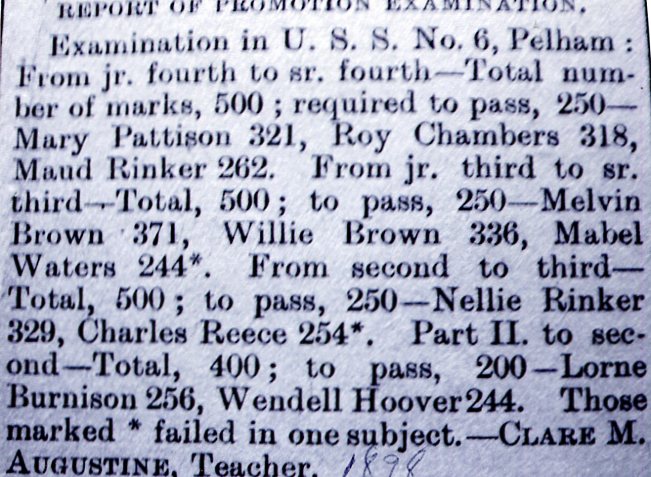 Mrs. Harrison has the original of this lease:
Mrs. Harrison has the original of this lease:
“1850 from Albert Renner to the trustees of School No. 6 in the township of Pelham, site for Schoolhouse on part of Lot 16, Concession 12, of said Township (Pelham) signed D. Deverardo, Conveyancer, Fonthill.
Teaching school was active in this area much earlier, for this receipt is in existance:- “Received from the trustees of School Section No. 6, in the township of Pelham, the sum of five pounds, ten shillings currency, in payment in full for the quarter ending the 22nd day of September, 1849.
Eliza F. Disher, Teacher.”
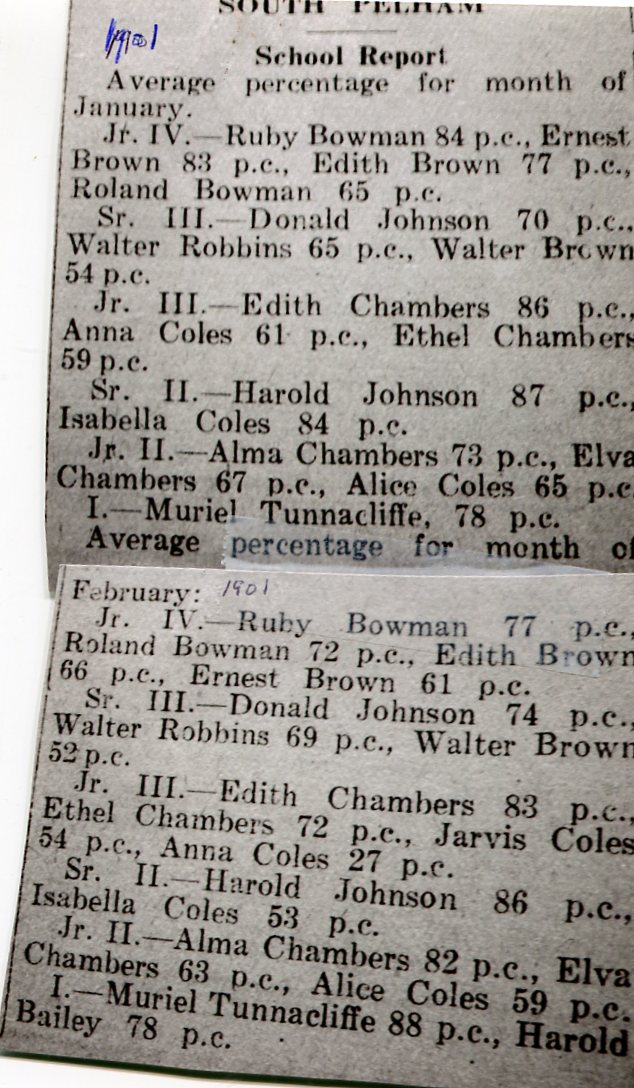 In 1861, it was stated that the payment in this school, for a “legally qualified teacher,” was to be “Ninety cents per day.” This was signed by Jacob Moore, S.W. Cant, Peter Beckett, Trustees and Sehin Thompson, Teacher. A School Notice of the Annual Meeting to be held at the schoolhouse, on the 2nd Wednesday in January, 1867, was sent out and signed by Peter Beckett and Peter Grant, Trustees. There was an added personal note by Peter Grant, “Ma wanted me to write you that we have a baby, and we call him Peter Muir. He is now five months old.
In 1861, it was stated that the payment in this school, for a “legally qualified teacher,” was to be “Ninety cents per day.” This was signed by Jacob Moore, S.W. Cant, Peter Beckett, Trustees and Sehin Thompson, Teacher. A School Notice of the Annual Meeting to be held at the schoolhouse, on the 2nd Wednesday in January, 1867, was sent out and signed by Peter Beckett and Peter Grant, Trustees. There was an added personal note by Peter Grant, “Ma wanted me to write you that we have a baby, and we call him Peter Muir. He is now five months old.
On Feb. 2, 1874, a letter was sent from the Clerk’s office, “Tp. Pelham, Ridegeville,” to Peter Grant Esq., Sec. Treas. Un, S.S. No. 6 Pelham, stating that “the half-yearly apportionment of the Pelham Clergy Reserves Fund for the half-year ending 31st December, 1873 has been placed to the credit of that School Section.” It amounted to thirty-one dollars! There was also the admonition that the money was only to be used to pay the teacher’s salary.
In 1874, the Journal of Education issued this statement: “Every child, from the age of 7-12 yr. Inclusive shall have the right to attend some school or be otherwise educated for four months of every year.” We have come a long way from that, but these little schools laid the foundation for Canada’s progress.


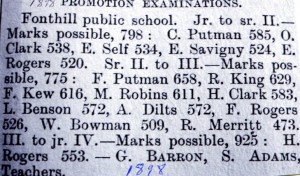
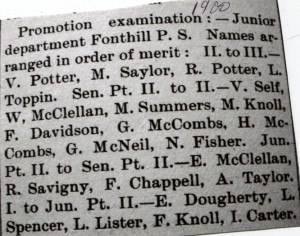


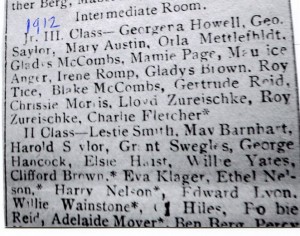
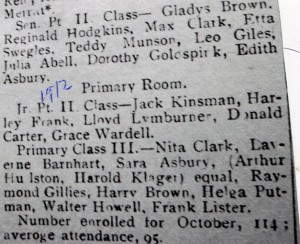


 Subscribe..
Subscribe..











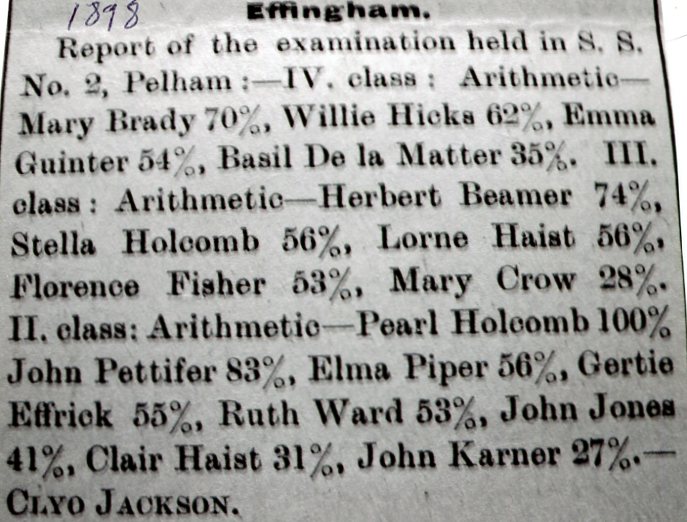



 Mrs. Harrison has the original of this lease:
Mrs. Harrison has the original of this lease: In 1861, it was stated that the payment in this school, for a “legally qualified teacher,” was to be “Ninety cents per day.” This was signed by Jacob Moore, S.W. Cant, Peter Beckett, Trustees and Sehin Thompson, Teacher. A School Notice of the Annual Meeting to be held at the schoolhouse, on the 2nd Wednesday in January, 1867, was sent out and signed by Peter Beckett and Peter Grant, Trustees. There was an added personal note by Peter Grant, “Ma wanted me to write you that we have a baby, and we call him Peter Muir. He is now five months old.
In 1861, it was stated that the payment in this school, for a “legally qualified teacher,” was to be “Ninety cents per day.” This was signed by Jacob Moore, S.W. Cant, Peter Beckett, Trustees and Sehin Thompson, Teacher. A School Notice of the Annual Meeting to be held at the schoolhouse, on the 2nd Wednesday in January, 1867, was sent out and signed by Peter Beckett and Peter Grant, Trustees. There was an added personal note by Peter Grant, “Ma wanted me to write you that we have a baby, and we call him Peter Muir. He is now five months old.